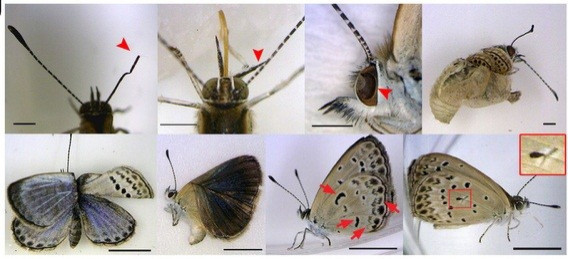Mutant Butterflies Found Near Fukushima Disaster Site

The toll of the radioactive fallout of the accident at the Fukushima Daiichi nuclear power plant in Japan has already begun to manifest itself in the form of mutant butterflies, according to a new study. (Whatever Mothra joke is springing to your lips is probably in poor taste.)
Finding mutant butterflies after an accident like the one at Fukushima, which earned a 7 out of 7 on the scale that the International Atomic Energy Agency uses to rate nuclear disasters, wouldn't exactly be a surprise. Previous work has found traces of radiation on Pacific bluefin tuna and in the air, ground and water around the accident. Scientists are still finding a high rate of abnormalities in the animals near Chernobyl, the site of the 1986 nuclear accident. Barn swallows living in heavily contaminated areas near Chernobyl are much more likely to have deformed beaks and tail feathers.
This latest paper, published August 9 in the journal Scientific Reports, details the physical and genetic changes wrought by the nuclear disaster upon local populations of Zizeeria maha, the pale grass blue butterfly.
"We conclude that artificial radionuclides from the Fukushima Nuclear Power Plant caused physiological and genetic damage to this species," the authors said.
Japanese researchers collected butterflies two months after the March 2011 meltdown and explosion and found some mild abnormalities among those that had been exposed to more radiation. Upon close inspection, male butterflies had smaller forewings at higher ground radiation doses.
But when they bred the butterflies they collected, the rate of mutations jumped up dramatically. The second generation had even more mutations: dented and deformed eyes; broken, wrinkled, or asymmetric wings; changes to color, antennae, body and legs.
Six months after the accident, the researchers collected another 238 butterflies and found widespread malformations - 28%, more than double the rate in the first field-collected group.
They also were able to produce similar abnormalities in the laboratory by exposing butterfly larvae and pupae to radioactive cesium or feeding them irradiated leaves collected from Fukushima.
The increased rate of abnormalities is probably more likely to the accumulation of mutations throughout successive generations, rather than continued radiation exposure, the researchers wrote.
However, "sensitivity [to irradiation] varies between species, so research should be conducted on other animals," University of the Ryukus researcher Joji Otaki told the Japan Times.
SOURCE: Hiyama et al. "The biological impacts of the Fukushima nuclear accident on the pale grass blue butterfly." Scientific Reports 2: 570, 9 August 2012.
© Copyright IBTimes 2025. All rights reserved.





















